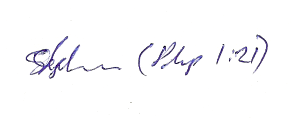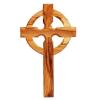I received an answer from Rick Meyers:
The note tags throughout the Bible are wrapped with the <not></not> tag. The text within those tags is N# or R# where the number is unique for that verse. (N = Note, R = Cross Reference, but everything could just be a Note as there is currently no difference.) You can choose how you number the notes. They can start at 1 and go up to however many notes are in the Bible, or you can restart at 1 for each Book, or each chapter, or each verse.
The formatting of the note text itself follows the exact same tagging rules as for the Bible text itself. The content of the notes is stored in a separate table.
Following are some examples from the NASB and NET Bibles for John 3:16. Please note that the tilde ~ is simply showing cell separation in the table row.
NASB
43~3~16~N1~<p>Or <i>unique,</i> only one of His kind</p>
43~3~16~R1~<p><ref>Rom 5:8</ref>; <ref>Eph 2:4</ref>; <ref>2Th 2:16</ref>; <ref>1Jn 4:10</ref>; <ref>Rev 1:5</ref></p>
43~3~16~R2~<p><ref>Rom 8:32</ref>; <ref>1Jn 4:9</ref></p>
43~3~16~R3~<p><ref>Joh 1:18</ref>; <ref>Joh 3:18</ref>; <ref>1Jn 4:9</ref></p>
43~3~16~R4~<p><ref>Joh 3:36</ref>; <ref>Joh 6:40</ref>; <ref>Joh 11:25</ref> f.</p>
NET
43~3~16~N36~<p><b>tn</b> Or “this is how much”; or “in this way.” The Greek adverb <grk>οὕτως</grk> (<lat>houtōs</lat>) can refer (1) to the <i>degree</i> to which God loved the world, that is, to such an <i>extent</i> or <i>so much</i> that he gave his own Son (see R. E. Brown, <i>John</i> [AB], 1:133-34; D. A. Carson, <i>John</i>, 204) or (2) simply to the <i>manner</i> in which God loved the world, i.e., by sending his own son (see R. H. Gundry and R. W. Howell, “The Sense and Syntax of <ref>Joh 3:14-17</ref> with Special Reference to the Use of <grk>Οὕτως</grk>…<grk>ὥστε</grk> in <ref>Joh 3:16</ref>, ” <i>NovT</i> 41 [1999]: 24-39)<b>.</b> Though the term more frequently refers to the manner in which something is done (see BDAG 741-42 s.v. <grk>οὕτω</grk>/<grk>οὕτως</grk>), the following clause involving <grk>ὥστε</grk> (<lat>hōste</lat>) plus the indicative (which stresses actual, but [usually] unexpected result) emphasizes the greatness of the gift God has given. With this in mind, then, it is likely (3) that John is emphasizing both the <i>degree</i> to which God loved the world as well as the <i>manner</i> in which He chose to express that love. This is in keeping with John’s style of using double entendre or double meaning. Thus, the focus of the Greek construction here is on the <i>nature</i> of God’s love, addressing its mode, intensity, and extent.</p>
43~3~16~N37~<p><b>tn</b> Although this word is often translated “only begotten,” such a translation is misleading, since in English it appears to express a metaphysical relationship. The word in Greek was used of an only child (a son [<ref>Luk 7:12</ref>, <ref>Luk 9:38</ref>] or a daughter [<ref>Luk 8:42</ref>]). It was also used of something unique (only one of its kind) such as the mythological Phoenix (1 Clement 25:2). From here it passes easily to a description of Isaac (<ref>Heb 11:17</ref> and Josephus, <i>Ant</i>. 1.13.1 [1.222]) who was not Abraham’s <i>only</i> son, but was one-of-a-kind because he was the child of the promise. Thus the word means “one-of-a-kind” and is reserved for Jesus in the Johannine literature of the NT. While all Christians are children of God (<grk>τέκνα θεοῦ</grk>, <lat>tekna theou</lat>), Jesus is God’s Son in a unique, one-of-a-kind sense. The word is used in this way in all its uses in the Gospel of John (<ref>Joh 1:14</ref>; <ref>Joh 1:18</ref>; <ref>Joh 3:16</ref>, and <ref>Joh 3:18</ref>).</p>
43~3~16~N38~<p><b>tn</b> In John the word <grk>ἀπόλλυμι</grk> (<lat>apollumi</lat>) can mean either (1) to be lost (2) to perish or be destroyed, depending on the context.</p>
43~3~16~N39~<p><b>sn</b> The alternatives presented are only two (again, it is typical of Johannine thought for this to be presented in terms of polar opposites): <i>perish</i> or <i>have eternal life</i>.</p>
As you can see, what you include for a note or cross reference is no different than for a commentary or other resource. Also note, the NASB restarts the numbering for each verse, whereas the NET restarts the numbering for each chapter. The choice is yours.
In His service,
Rick Meyers




















